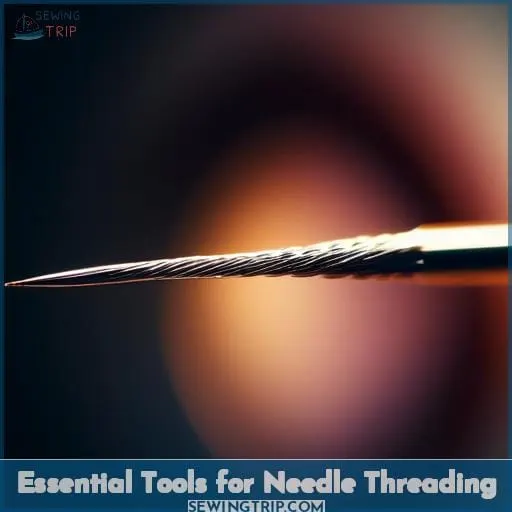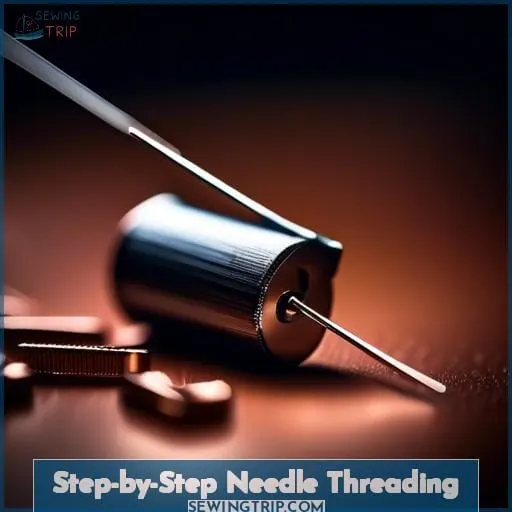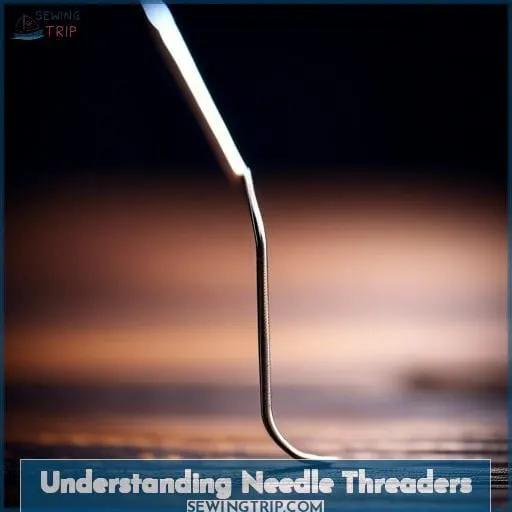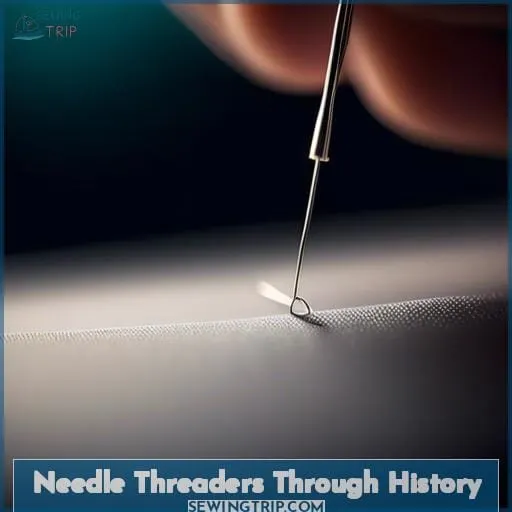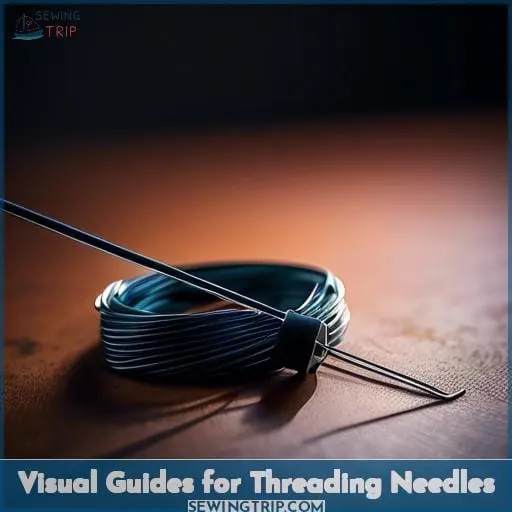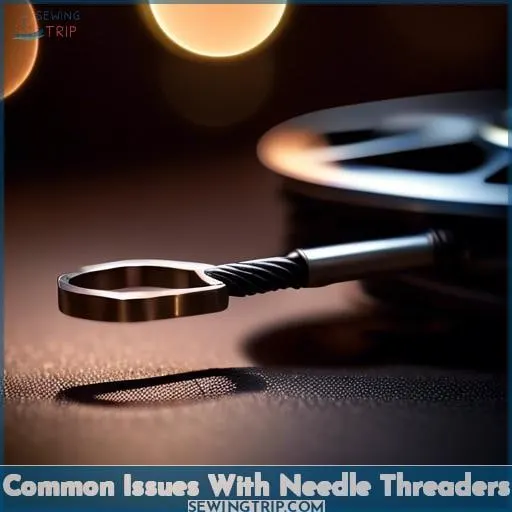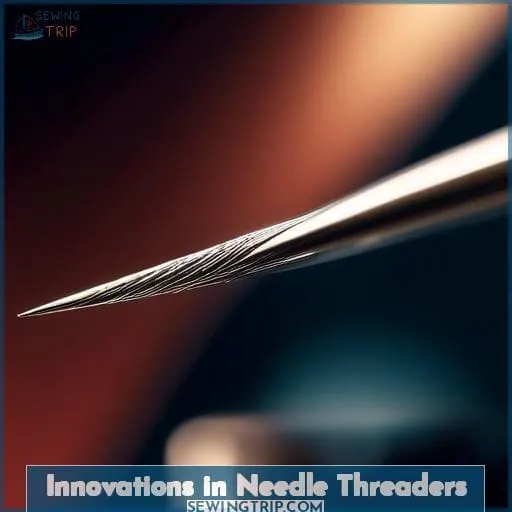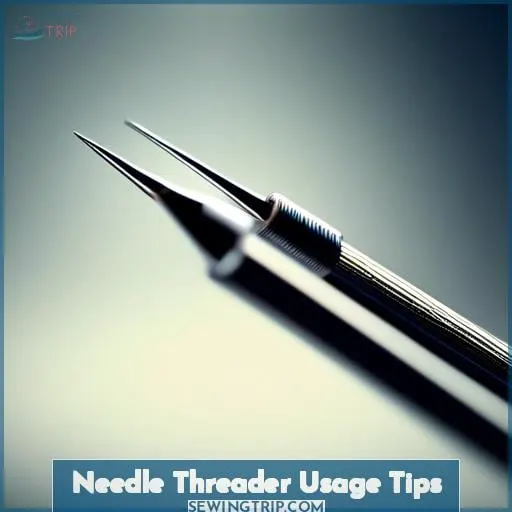This site is supported by our readers. We may earn a commission, at no cost to you, if you purchase through links.
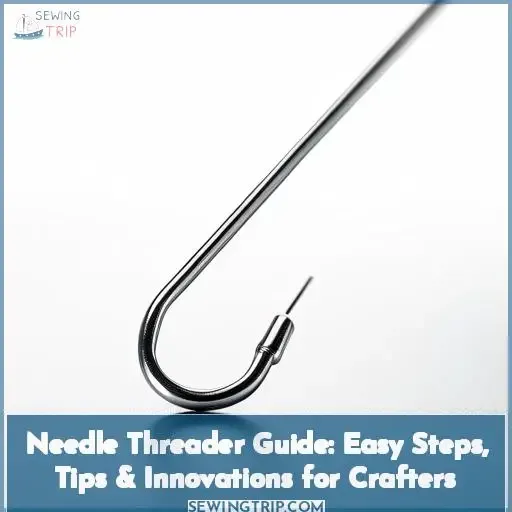
In this guide, you’ll learn how a needle threader works and discover various types that can make your crafting smoother.
We’ll provide easy steps and tips to master this handy tool, along with innovative designs that address common issues.
Whether you’re a seasoned crafter or just starting out, this guide will enhance your sewing experience with practical advice and creative insights.
Table Of Contents
- Key Takeaways
- How Does a Needle Threader Work
- Essential Tools for Needle Threading
- Step-by-Step Needle Threading
- Understanding Needle Threaders
- Needle Threaders Through History
- Visual Guides for Threading Needles
- Common Issues With Needle Threaders
- Innovations in Needle Threaders
- Needle Threader Usage Tips
- Finding Needle Threaders
- Frequently Asked Questions (FAQs)
- Conclusion
Key Takeaways
- Needle threaders simplify the process of threading a needle by using a diamond-shaped wire loop or a metal hook that passes through the eye of the needle, allowing the thread to be easily pulled through.
- There are various types of needle threaders available, ranging from basic and fragile to durable and specialized, including those designed for cross-stitching or use with sewing machines.
- The general method for using a needle threader involves inserting the wire loop into the needle’s eye, threading the wire loop with the thread, and then pulling the threader out to thread the needle.
- Recent innovations in needle threaders include more robust designs, looped threaders for easier handling, features like a hummingbird design for aesthetic appeal, magnetic backing for convenience, and replaceable wires for longevity.
How Does a Needle Threader Work
Yes, a needle threader works by inserting its wire loop or hook through the eye of a needle, then the thread is passed through the loop, and finally, the threader is pulled back through the needle’s eye, threading the needle.
Essential Tools for Needle Threading
You’ll need a needle, some thread, and a needle threader to start your sewing project.
Choose from various threader types to best suit your needle and thread size.
Needle
In the dance of needle threading, your needle choice and thread selection are the lead partners.
Under the spotlight of good lighting and with a magnifier as your backstage crew, even dexterity challenges can’t stop the show.
Cue the needle threader!
Thread
After choosing your needle, let’s talk thread.
The right thread type, weight, and color can make or break your project. Keep thread tension in mind and store it neatly.
At your local needlework shop, find automatic needle threaders to breeze through threading.
Needle Threader Types
In the crafting game, needle threaders are your MVPs.
From cheap breakables to hardy heroes, there’s a threader for every stitch situation.
Whether you’re a cross-stitch connoisseur or a sewing machine sidekick, finding your needle-threading sidekick can make or break your project.
Step-by-Step Needle Threading
You’ll start by inserting the wire loop of your needle threader through the eye of the needle.
Next, slip the end of your thread through the wire loop and then pull the threader back out, bringing the thread with it.
Insert Wire Loop
Slide the wire loop of your threader through the needle’s eye.
Choose your wire type and loop shape wisely for durability.
For small needles or beading, consider a flat hook or Puffin & Co threader.
This boosts threading speed and makes crafting more accessible.
Thread Tail Insertion
Once you’ve got the wire loop through the needle’s eye, it’s showtime:
- Steady the thread’s end.
- Gently guide it through the loop.
- Keep it snug, avoiding tangles.
Threading tiny needles? Piece of cake with the right needle threader!
Pulling Through the Eye
Once you’ve got the thread tail in the wire loop, it’s showtime!
Gently tug the threader, and voilà, your needle’s threaded.
It’s like finding a needle in a haystack, but with the right tools, it’s a piece of cake!
Understanding Needle Threaders
You’ll find that needle threaders come in various designs, each with a specific purpose to ease your sewing tasks.
They typically feature a diamond-shaped wire loop or a metal hook that slips through the eye of a needle, simplifying the threading process.
Metal Tool Design
After mastering the threading dance, let’s dive into the tool’s design.
Your needle’s shape, thread material, and even lighting conditions matter.
For those tiny-eyed needles in cross-stitch projects or delicate soie de paris ladder stitches, a micro threader from Puffin & Company becomes your best ally.
Diamond-Shaped Wire Loop
You’re about to meet your needle’s best friend: the diamond-shaped tool. Here’s why it’s a gem:
- Wire Loop Design: Slides through needle eyes like butter.
- Metal Hook Variations: Adapts to any thread challenge.
- Historical Origins: A time-tested, innovative companion.
Metal Hook Variants
Switching gears to metal hook variants, you’ll find they’re a stitch above in durability comparisons. Ergonomic designs and hook size options cater to your cross-stitch applications, ensuring you’re not left hanging by a thread.
| Hook Size | Best For |
|---|---|
| Small | Delicate Fabrics |
| Medium | General Sewing |
| Large | Bulky Yarns |
| Extra-Large | Canvas Work |
| Varied Set | Versatility |
Needle Threaders Through History
Needle threaders have been aiding crafters since their first known use in Europe in the late 18th or early 19th century.
This tool’s evolution over the centuries reflects its enduring importance in sewing and embroidery.
European Origins
Dive into the past where European needleworkers crafted with early needle tools, predating the nifty gadgets we use today.
Imagine medieval sewing instruments, less refined but cherished by historical needlework guilds.
The needle threader’s tale begins here, a brainchild of necessity, evolving from these humble origins.
It’s a salute to those who threaded needles before us, without the luxury of our modern aids.
Evolution Over Centuries
Over centuries, needle threaders have undergone a fascinating evolution. Here’s a quick rundown:
- Early Beginnings: Initially simple tools, they’ve transformed, adapting to crafters’ needs.
- Design Innovations: From basic wire loops to intricate designs, each iteration brought new solutions to age-old threading challenges.
- Usage Expansion: No longer just for sewing, their versatility now aids in a myriad of crafting projects, showcasing the relentless pursuit of innovation in everyday tools.
Visual Guides for Threading Needles
After diving into the rich history of needle threaders, let’s shift our focus to visual guides for threading needles.
YouTube is a goldmine for crafters craving a visual feast of threading techniques. Whether you’re wrestling with wire threaders that seem to have a mind of their own or exploring the world of micro threaders and needle minders, there’s a tutorial for you.
These videos are like having a patient mentor right beside you, guiding your every move. From the classic struggle with the thread slipping away just as you think you’ve nailed it, to the triumph of discovering threader types that feel like they were made just for you, visual guides are your secret weapon.
They transform the sometimes-frustrating task of threading a needle into a moment of aha! So, grab your needle threader, and let’s make threading a breeze.
Common Issues With Needle Threaders
You might find that your needle threader’s wire breaks easily, especially with smaller needles.
This issue can make threading a challenge, despite the tool’s intended convenience.
Wire Breakage
Wire breakage in needle threaders can feel like hitting a snag in your crafting journey.
A sturdy handle design can make a world of difference, as can exploring alternative materials.
Difficulty With Small Needles
Threading those pesky small needles can feel like trying to thread a camel through the eye of a needle!
But don’t fret; a micro needle threader can be your tiny but mighty sidekick.
Ensure you’ve got good lighting and magnification to turn this tricky task into a clear-cut victory.
Opt for a threader with a durable wire or a sturdy flat-hook or humming threader hook to dodge the breakage blues.
Innovations in Needle Threaders
You’ll find that innovations in needle threaders have made the task easier and more efficient.
Brands like Clover and LoRan offer sturdy designs. The Dritz looped threaders and Hummingbird features add convenience to your sewing projects.
Clover and LoRan Designs
When exploring needle threaders, consider these standout features:
- Clover quality: Thin, flat metal, ideal for cross stitch.
- LoRan durability: Sturdy, side-loaded design.
- Dritz affordability: Hardy looped threaders.
Hummingbird’s ergonomic design and Puffin’s innovative approach also merit attention.
Dritz Looped Threaders
After exploring Clover and LoRan’s unique takes, let’s dive into Dritz Looped Threaders. These gems boast a looped wire and metal ring, ensuring threader durability. Their handle design is a game-changer, making threading a breeze.
| Feature | Benefit | Why It Matters |
|---|---|---|
| Looped Wire | Less breakage | Saves time |
| Metal Ring | Enhanced strength | Longevity |
| Handle Design | Easy to grip | User-friendly |
Embrace the simplicity and strength of Dritz Looped Threaders.
Hummingbird Threader Features
After diving into the sturdy Dritz looped threaders, let’s lighten the mood with the Hummingbird needle threader.
- A nifty hook system.
- A protective hook cover.
- Its compact size.
- An affordable price tag and magnetic backing.
A true crafters’ delight!
Needle Threader Usage Tips
Threading needles for small-scale embroidery can be tricky, but don’t worry.
Here are some troubleshooting tips to help you out.
First, ensure that the needle is correctly positioned with its eye at the appropriate level for the threader’s hook to pass through.
If your machine has a needle up/down button, use it to bring the needle to its highest position.
Otherwise, manually adjust the needle using the handwheel.
Avoid attempting to thread needles smaller than size 70/10, as their eyes are too small for the threader’s hook and can lead to damage.
Also, match the thread size to the needle, using garment construction thread for best results.
Avoid using the threader with metallic or stiff threads, as they can damage the hook.
Finally, remember to release the thread as soon as the hook starts pulling it through the eye to avoid applying tension that could harm the hook.
If these tips don’t resolve the issue, your threader might need professional adjustment or replacement.
Threading Small-Scale Embroidery
After exploring innovative threaders, let’s dive into threading small-scale embroidery. Choosing the right threader is crucial. Consider the needle eye diameter and opt for alternative threaders if standard ones don’t cut it.
| Needle Size | Threader Type | Visual Aid |
|---|---|---|
| Small | Micro Threader | Magnifier |
| Medium | LoRan | LED Light |
| Large | Dritz Looped | App Guide |
| Tiny | Puffin & Co. | YouTube |
| All | Hummingbird | DIY Hack |
Troubleshooting Tips
- Swap to advanced threaders with a magnetic hook for a grip that won’t slip.
- If the wire breaks, don’t throw in the towel—some threaders offer replaceable wires for continued durability.
- Remember, accessibility is key; choose tools that turn needle threading from a chore into a breeze.
Finding Needle Threaders
If you’re looking for needle threaders, local needlework or quilting shops often carry a variety.
For a specialized option like the Puffin & Company Micro Threader, you can order directly from their website or through retailers like Needle in a Haystack.
Local Shops and Online Retailers
Hunting for the perfect needle threader? Dive into your local craft store or quilt shop for a hands-on selection experience.
If you’re a fan of convenience, online retailers offer a buffet of choices, from the humble wire loop to the nifty micro threader. Compare options from the comfort of your couch, but remember, not all threaders are created equal.
Choose wisely and let your crafting adventure begin!
Puffin & Company Micro Threader
When threading those pesky small needles, the Puffin & Company micro threader is your secret weapon. Its acorn shape isn’t just cute; it’s functional, with a magnet backing to cling to your work area.
Remember, a careful rocking motion is key to success. Watch out for the occasional burr on the hook, though—it’s a rare hiccup in an otherwise smooth process.
- Keep it close with the magnet backing.
- ️ Adorable acorn shape doubles as decor.
- 瑱 Master small needles with a gentle rock.
- Inspect for burrs to avoid snags.
- Puffin & Company brings ease to threading.
Frequently Asked Questions (FAQs)
Can needle threaders be repaired if broken?
Yes, you can fix a broken needle threader!
If the hook’s bent, just nudge it back into place with a seam ripper or small screwdriver.
It’s a quick fix that’ll save you a trip to the repair shop.
Are needle threaders safe for children’s use?
Navigating a needle’s eye can be like threading a camel through a needle’s eye. However, needle threaders simplify this task. They’re generally safe for kids, turning a tricky task into child’s play with proper supervision.
How do environmental factors affect needle threaders?
Environmental factors like poor lighting or high humidity can make threading needles a real knuckle-biter. This can potentially cause threaders to bend or rust, turning a quick stitch into a stitch-witch situation.
Do needle threaders work with all thread types?
Like a key fitting into a lock, needle threaders work with various thread types, from fine silk to bulky yarn.
However, the perfect match depends on the threader’s design and the needle’s eye size.
Can needle threaders cause damage to needles?
Yes, needle threaders can damage needles, especially if forced through tiny eyes or used improperly.
It’s like trying to fit a square peg in a round hole—frustrating and potentially harmful to your sewing buddies.
Conclusion
Just as a compass guides a sailor through uncharted waters, understanding how a needle threader works can steer you through the challenges of threading needles with ease.
This guide has illuminated the path from selecting the right tools to mastering innovative threaders that simplify your crafting journey.
Armed with these insights, you’re now equipped to tackle any threading task with confidence. Let the needle threader be your ally, making every stitch smoother and your crafting experience more enjoyable.

